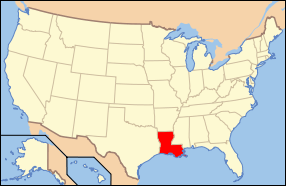Albany, Louisiana
| Albany, Louisiana | |
| Village | |
| Hungarian Settlement School in Albany | |
| Country | United States |
|---|---|
| State | Louisiana |
| Parish | Livingston |
| Elevation | 39 ft (11.9 m) |
| Coordinates | 30°30′12″N 90°35′02″W / 30.50333°N 90.58389°WCoordinates: 30°30′12″N 90°35′02″W / 30.50333°N 90.58389°W |
| Area | 1.1 sq mi (2.8 km2) |
| - land | 1.1 sq mi (3 km2) |
| - water | 0.0 sq mi (0 km2), 0% |
| Population | 1,088 (2010) |
| Density | 778.2/sq mi (300.5/km2) |
| Incorporated | October 7, 1953 |
| Mayor | Gene Glascock (R) |
| Timezone | CST (UTC-6) |
| - summer (DST) | CDT (UTC-5) |
| Area code | 225 |
 Location of Albany in Louisiana
| |
 Location of Louisiana in the United States
| |
| Website: http://www.city-data.com/city/Albany-Louisiana.html | |
Albany is a village in Livingston Parish, Louisiana, United States. The population was 1088 at the 2010 census. It is part of the Baton Rouge Metropolitan Statistical Area.
District 95 State Representative Sherman Q. Mack, an attorney, resides in Albany.
History
The settlement was established in 1896 by Hungarians, under the name Árpádhon (Árpád, the leader of the Hungarian tribes and -hon as home(land)).[1] According to another source, Albany was named from the Natalbany River, a name which is of Native American origin.[2]
Geography
Albany is located at 30°30′12″N 90°35′2″W / 30.50333°N 90.58389°W (30.503218, -90.583986).[3]
According to the United States Census Bureau, the village has a total area of 1.1 square miles (2.8 km2), all land.
Demographics
| Historical population | |||
|---|---|---|---|
| Census | Pop. | %± | |
| 1960 | 557 | — | |
| 1970 | 700 | 25.7% | |
| 1980 | 857 | 22.4% | |
| 1990 | 645 | −24.7% | |
| 2000 | 865 | 34.1% | |
| 2010 | 1,088 | 25.8% | |
| Est. 2015 | 1,104 | [4] | 1.5% |
As of the census[6] of 2000, there were 865 people, 371 households, and 234 families residing in the village. The population density was 778.2 inhabitants per square mile (300.9/km²). There were 409 housing units at an average density of 368.0 per square mile (142.3/km²). The racial makeup of the village was 97.69% White, 0.12% African American, 0.35% Native American, 0.12% Asian, 0.81% from other races, and 0.92% from two or more races. Hispanic or Latino of any race were 1.50% of the population.
There were 371 households out of which 32.1% had children under the age of 18 living with them, 47.4% were married couples living together, 11.1% had a female householder with no husband present, and 36.7% were non-families. 32.1% of all households were made up of individuals and 16.7% had someone living alone who was 65 years of age or older. The average household size was 2.33 and the average family size was 2.92.
In the village the population was spread out with 25.7% under the age of 18, 9.7% from 18 to 24, 29.7% from 25 to 44, 20.3% from 45 to 64, and 14.6% who were 65 years of age or older. The median age was 34 years. For every 100 females there were 92.7 males. For every 100 females age 18 and over, there were 89.1 males.
The median income for a household in the village was $25,208, and the median income for a family was $39,167. Males had a median income of $35,000 versus $21,111 for females. The per capita income for the village was $16,407. About 14.3% of families and 20.3% of the population were below the poverty line, including 16.8% of those under age 18 and 27.7% of those age 65 or over.
Cultural and historic sites
Historic Hungarian Settlement is in Albany. In 1900, there were eleven families living in the Hungarian Settlement and by 1908 there were about forty Hungarian families on new farms in the area. By 1910, there were sixty-five families. In 1920, there were about two hundred families on farms in the area. So one can see the rapid growth within just twenty years.
Since 1905 population of the area continued to grow and the Hungarians wanted a place of their own to worship. In 1909, a twenty-acre church site was donated by Mr. and Mrs. Joseph Juhasz and in that same year, Archbishop James Blenk from the Archdiocese of New Orleans approved the official name of St. Margaret Queen of Scotland Church]
Albany Plantation, which promotes the heritage of the French Cajun culture of Louisiana, sits on 34 acres of land.
Education
Albany is within the Livingston Parish Public Schools system.
Schools that serve Albany include:
- Albany Lower Elementary School (Louisiana)
- Albany Upper Elementary School (Louisiana)
- Albany Middle School (Louisiana)
- Albany High School
References
- ↑ Community-hist
- ↑ Leeper, Clare D'Artois (19 October 2012). Louisiana Place Names: Popular, Unusual, and Forgotten Stories of Towns, Cities, Plantations, Bayous, and Even Some Cemeteries. LSU Press. p. 12. ISBN 978-0-8071-4740-5.
- ↑ "US Gazetteer files: 2010, 2000, and 1990". United States Census Bureau. 2011-02-12. Retrieved 2011-04-23.
- ↑ "Annual Estimates of the Resident Population for Incorporated Places: April 1, 2010 to July 1, 2015". Retrieved July 2, 2016.
- ↑ "Census of Population and Housing". Census.gov. Archived from the original on May 11, 2015. Retrieved June 4, 2015.
- ↑ "American FactFinder". United States Census Bureau. Archived from the original on 2013-09-11. Retrieved 2008-01-31.
External links
- Albany Louisiana City Data
- Hungarian Settlement Museum
- St. Margaret Queen of Scotland Church
- Árpádhon Hungarian Settlement Cultural Association
| Wikimedia Commons has media related to Albany, Louisiana. |
